Nevada events abound as campaigns 'more aware that the Asian vote matters'
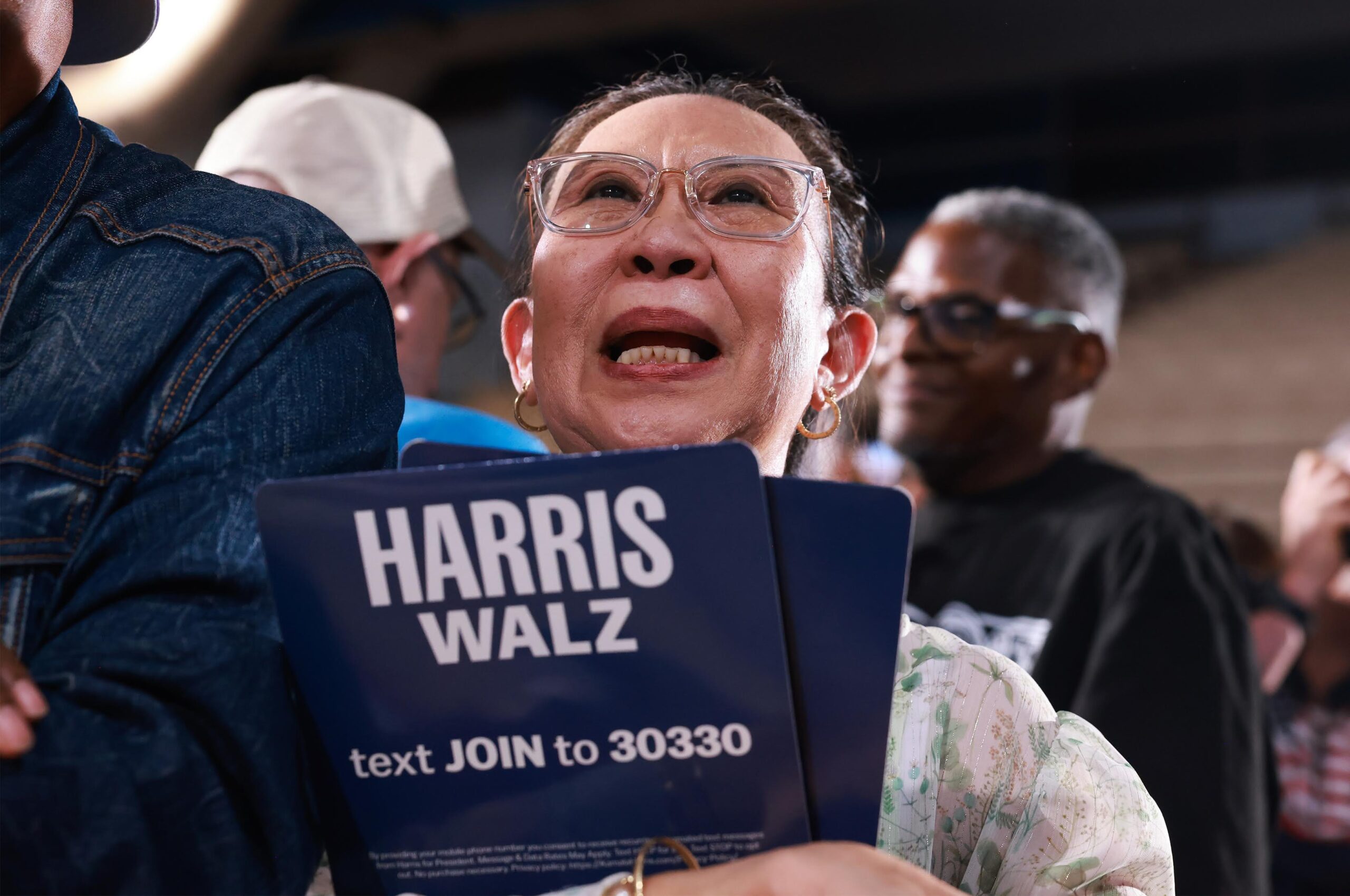
At an Oct. 16 meet and greet with Las Vegas’ South Asian community, attendees snacked on aloo tikki and Indian chicken tacos, mingled with politicians and took in the moment.
Sen. Jacky Rosen (D-NV), engaging with community members by name, spoke about growing small businesses and the importance of participating in the election. Rep. Susie Lee (D-NV), who represents the Asian American Pacific Islander-heavy (AAPI) Spring Valley and southwestern Las Vegas area, shook hands. And Maya Harris, the vice president’s sister, received an enthusiastic cheer from the audience when she stopped by.
Multiple attendees reported that their elderly parents were politically engaged for the first time, excited by the prospect of sending an Indian American to the White House.
“I'm feeling very positive, very optimistic,” said Assemblyman Reuben D’Silva (D-North Las Vegas), Nevada’s first South Asian elected official. “Kamala Harris' candidacy has really energized the South Asian community in a very dramatic way. She’s Auntie Kamala.”
While Harris’ identity has contributed to outsized enthusiasm within Las Vegas’ South Asian community, campaigns from both parties have traversed the Las Vegas Valley courting AAPI voters, a critical, growing bloc who could decide several of the state’s close elections. As 12 percent of the Nevada electorate — with 45 percent population growth since 2012 — campaign outreach has reflected the significance and diversity of AAPI voters.
Among the seven swing states, Nevada has the highest percentage of AAPI voters. In 2020, exit polls showed that AAPI voters backed now-President Joe Biden by an 18-percentage-point margin.
Community leaders and Asian Americans working in Nevada politics said that partisanship is often less sticky among AAPI voters, particularly older ones, and that split ticket voting isn’t uncommon. With much lower turnout in 2022, exit polls showed AAPI voters broke for Sen. Catherine Cortez Masto (D-NV) by a 14-percentage-point margin, but Gov. Steve Sisolak (D) by only 8 percentage points.
Harris’ campaign has hosted a kamayan — a communal feast — and announced her “Pinoy pride” in ads to target Filipino American voters. Former President Bill Clinton popped up at Seafood City Supermarket, a popular shopping destination for the Filipino community, to stump for Harris. Sisolak and his wife, Kathy, who is Chinese American, and AAPI Assembly members led a march to polls in Chinatown on Friday.
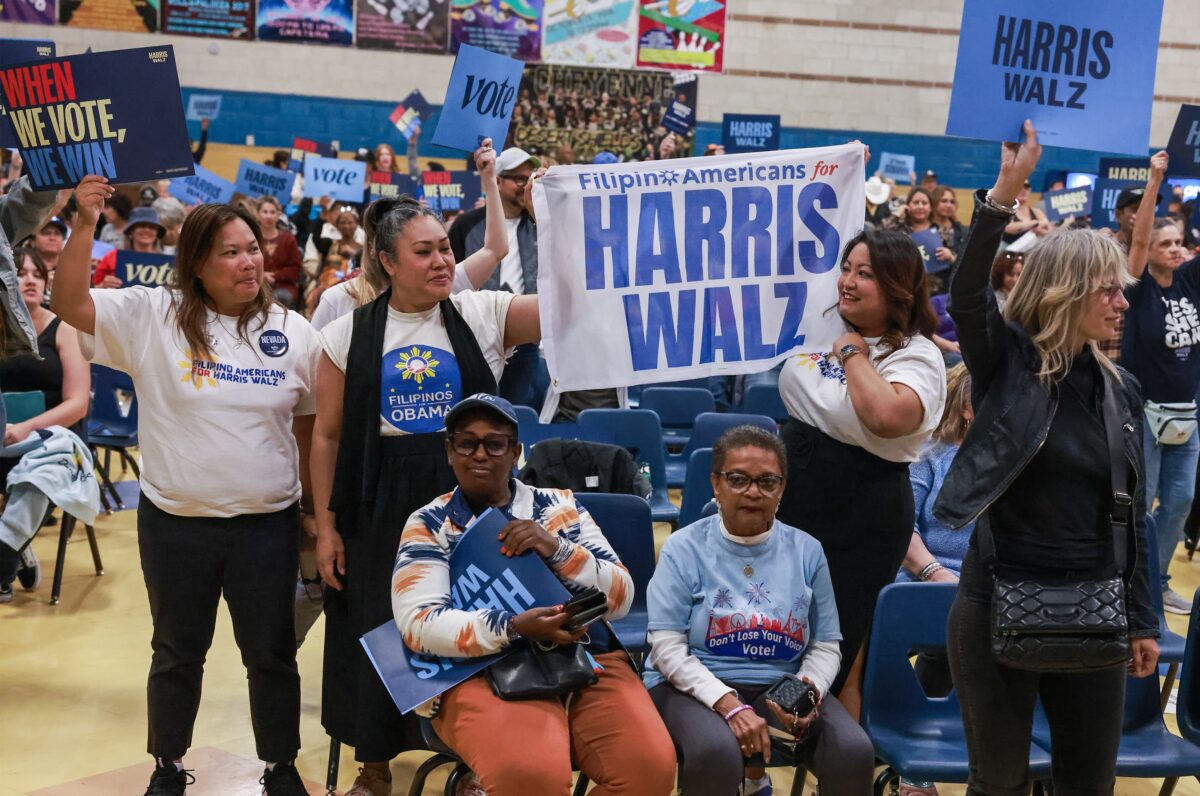
Sam Brown, the Republican candidate for Senate, wore a traditional Filipino barong and pledged to counter Chinese aggression toward the Philippines. Former President Donald Trump came to Las Vegas on Oct. 24 with key Asian American surrogates to court voters, believing his campaign will grow its margins with AAPI voters this cycle.
Eric Jeng, the executive director of progressive AAPI political advocacy group One APIA Nevada, said the abundance of events show how campaigns are now casting a wider net.
“Can you imagine you’re a Filipino auntie, and you’re just at [Seafood City Supermarket] to buy groceries, and then Bill Clinton shows up?” Jeng said. “They used to do this every election cycle, but now they also come with a lot earlier investments into the community.”
Ana Wood, the director of the Las Vegas Asian Chamber of Commerce (LVACC), agreed this cycle feels extra busy.
“[Politicians] are more involved,” Wood said. “They are more aware that the Asian vote matters.”
For a voter bloc that has typically been ignored, in a self-enforcing cycle of low engagement, turnout and representation, the change is evident and invigorating. In just a few cycles, outreach has become more culturally specific, the AAPI percentage of the electorate has grown and the Legislature has seen an influx of Asian American members — all Democrats, at this point.
Assemblywoman Erica Mosca (D-Las Vegas), a senior adviser on the Harris campaign in Nevada and the first Filipina American in the Legislature, remembered how excited she was in 2016 when Hillary Clinton’s campaign hosted a kamayan.
“Back then, like you have one [event], and that was the Filipino outreach,” Mosca said. “Now it's a blitz all the time. There's always something.”
“Not a monolith”
The focus makes sense — Filipino Americans are the largest and fastest-growing segment of the AAPI population, estimated at 44 percent, according to Asian and Pacific Islander Vote (APIAVote). Next biggest is Chinese Americans, at about 14 percent, and then Japanese Americans at 7.5 percent. Native Hawaiians, Korean Americans, Asian Indian Americans and Vietnamese Americans each make up about 5 percent of the AAPI population.
Though they trend Democratic, priorities and attitudes differ across ethnicity, age and immigration experience — 60 percent of the AAPI citizen population in Nevada was born in the U.S. According to national data from the Pew Research Center, about two-thirds of Filipino, Korean and Indian Americans identify as Democrats, while Vietnamese Americans are more likely to be Republicans and Chinese Americans lean Democratic at slightly lower levels.
Partisanship is highly correlated with age — nearly 90 percent of AAPI voters younger than 30 are Democrats, while Asian American seniors are close to an even partisan split. And U.S.-born Asian voters are far more likely to be Democrats than those born in a foreign country.
“It's not a monolith,” Jeng said. “It's not the old stereotype of [the] model minority.”
Some issues cut across ethnicity. Nearly everyone interviewed for this story identified the economy as the top issue for AAPI voters. Small-business policy is a chief interest for the vast array of AAPI small-business owners across the Las Vegas Valley.
“All those [rising costs] affect the Asian businesses,” said Wood, whose organization has endorsed both candidates of both parties for the Legislature. “They're finding that they have financial challenges. And I'm not talking just about restaurants — I'm talking about even the spas, nail salons, dry cleaners.”
Concerns about democracy are prevalent, particularly among immigrants who fled oppressive regimes and their children who grew up hearing about their parents’ experiences. Many AAPI voters are also troubled by the surge in hate crimes against Asian Americans that began during the pandemic, and Trump’s rhetoric — including referring to COVID-19 as the “China flu” or “Chinese virus” — that helped fuel it.
But outreach can look different depending on the group. Even though many older Filipinos, in particular, are devout Catholics and are personally anti-abortion, Mosca said Harris’ messaging strategy to frame abortion as a matter of freedom resonates.
“Older folks … remember what it was like under [dictator Ferdinard] Marcos and they fled to come here,” Mosca said. “Under the Marcos regime, you did not have a choice either way.”
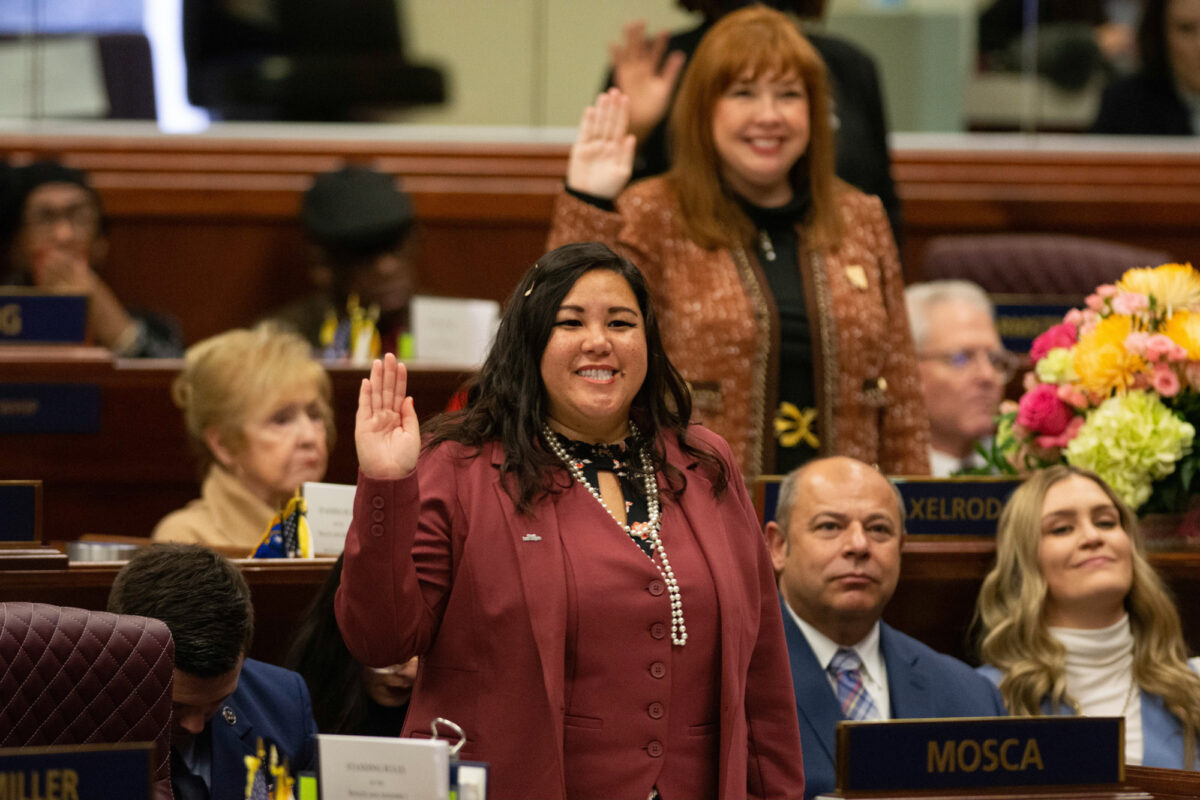
Republicans believe that their military and Catholic backgrounds make Filipino Americans persuadable.
Pauline Lee, the president of the Nevada Republican Club and a Chinese American, said she hopes to make inroads with Filipinos in the same way that Republicans have had success with Vietnamese and some Chinese Americans — raising concerns about communism, given the Philippines had an active insurgent communist movement.
“Older Filipinos who came to this country are all conservative,” Lee said. “And they go to church.”
That age divide can be consistent across ethnic groups as well.
Caitlin Gatchalian, the chair of the Nevada AAPI Democrats, said she’s encouraging board members to talk to their parents about the election, and try to connect their immigration stories to Harris’ messaging on the “opportunity economy” — a key part of her appeal to Latino voters as well.
Wood said she expects many AAPI voters, particularly the state’s growing number of nonpartisans, to be late deciders. But that doesn’t mean they aren’t paying attention.
“Asians are very vigilant,” Wood said. “They want to make sure that the individuals that they are going to be voting for are well-educated [on the issues].”
Democratic campaigns
Numerous Democrats said the best thing that happened this cycle — up and down the ballot — was the ascension of Harris. It’s not just that she’s Asian American, they say, but that her campaign in Nevada is well-versed in cultural specificity.
“With the Harris campaign, the outreach was happening organically,” said Gatchalian, noting that groups such as “Filipinos for Harris” and “Korean Americans for Harris” popped up without prodding from the AAPI Caucus. “[They know] this is a wave we should be riding.”
Advocates acknowledge that more voter contact is necessary — only 44 percent of registered AAPI voters reported contact from Democrats in the 2022 midterm, compared to 35 percent among Republicans, per APIAVote. But AAPI voters’ Democratic lean, and the enthusiasm that staffers see in the community — one campaign official noted that they always get compliments when wearing their Harris-Walz gear in Asian grocery stores — means that the Harris campaign’s operation has been able to focus more on turnout rather than persuasion.
This has resulted in a major emphasis on events and engagement with small businesses. The campaign itself has hosted numerous get out the vote events with surrogates at restaurants such as Chinatown Plaza’s Xiao Long Bao Dumplings and Chaska Indian Street Food.
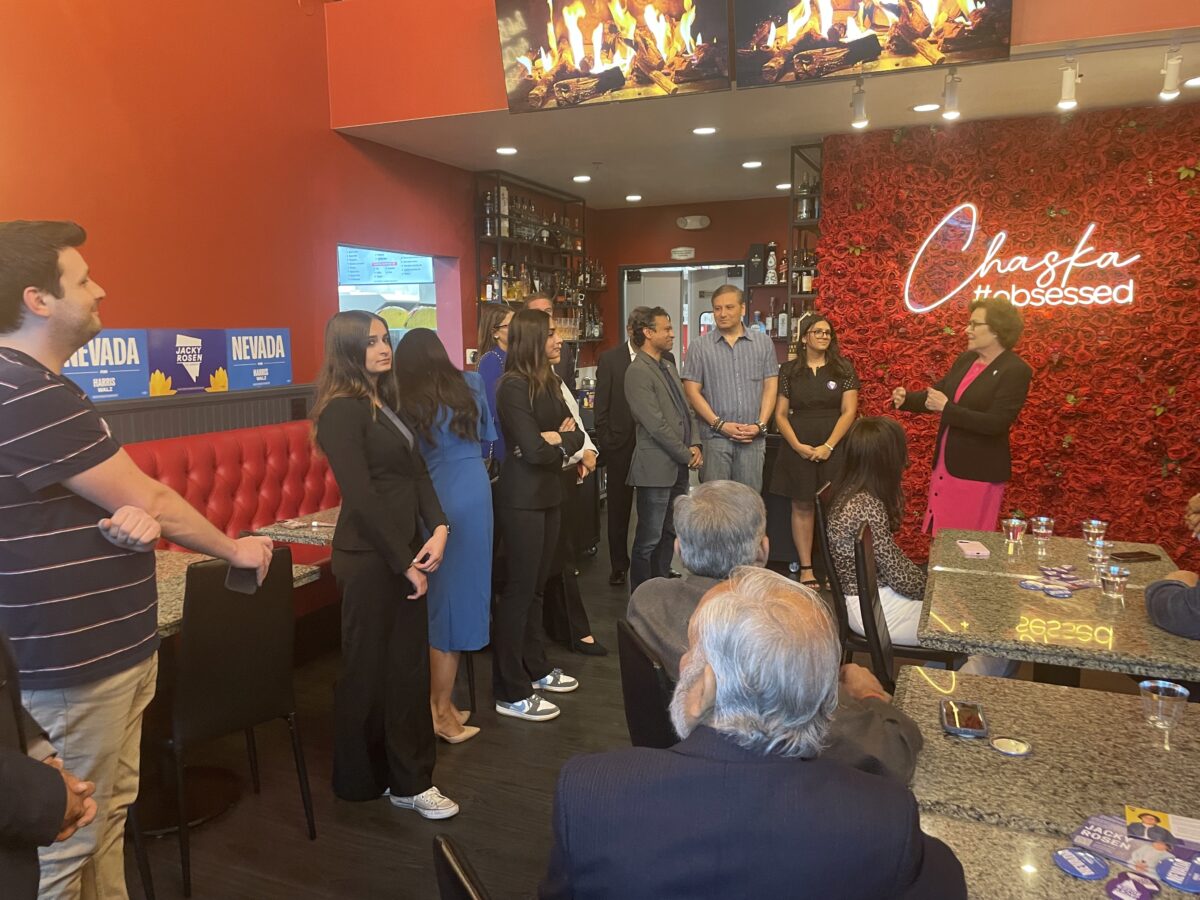
AAPI Democrats is hosting a silent disco Nov. 2, with free entry contingent on having canvassed for a Democratic candidate. One APIA Nevada has scheduled halo halo-ween, themed around the Filipino drink, and a Diwali celebration.
Each cycle, AAPI voters get more familiar with interacting with their elected officials and engaging in electioneering. In the off years, groups such as Jeng’s have brought AAPI constituents to Carson City and Washington, D.C., to engage with the legislative process, which breeds more activity during the election season.
“More and more community members are involved,” Jeng said. “That means more and more people are being able to pitch creative ideas that speak to their specific community, specific heritage.”
On its PAC side, One APIA says it has also knocked on more than 170,000 doors, with a goal of hitting 200,000 — mostly on the southwest side of the Las Vegas Valley — and produced political videos themed like Korean dramas. The group has endorsed Harris, Rosen and Susie Lee, whose district is nearly one-fifth AAPI.
While Jeng said neither presidential candidate has run away with the AAPI vote based on his interactions on the doors, he said he engages with more Harris supporters than those for Trump — but that many AAPI voters like to keep their decision close to the vest.
Rosen, who has been particularly engaged with AAPI small-business owners throughout her term from her perch on the Small Business Committee, speaks about being the grandchild of immigrants, wanting a better life for the next generation and joining the Congressional Asian Pacific American Caucus. Susie Lee’s outreach has ranged from ballot language access initiatives to tours of businesses in Chinatown.
“With the AANHPI community, my background in education resonates very well,” said Susie Lee, who used to run an education nonprofit. “Choice is interesting. Older Filipinos tend to run a little more Catholic. I grew up Catholic, so I can have those conversations with them, that you can oppose it, but you can still allow women to make their own choices.”
Jeng said the Democratic incumbents also have the advantage of years’ worth of interactions with the AANHPI community, from casework requests to community events. D’Silva said both Nevada senators and Susie Lee have been good at a critical element of AAPI voter outreach — just showing up, which fosters familiarity that drives turnout.
“For a lot of immigrants, they want to not rock the boat too much,” said Chintan Desai, an Indian American and senior adviser to Assemblyman Duy Nguyen (D-Las Vegas). “But it is important to have our voices heard. Sen. Rosen being top of the ticket, being such an ally to the community here — the South Asian community in particular — is incredibly important.”
Republican outreach
The fact that Trump had an AAPI-themed rally — less than two weeks before the election — demonstrates the optimism Republicans have about the voter bloc. But it also revealed some of the roadblocks — outside of praising Filipino clothing, Trump had few culturally specific pitches to offer and repeated the term “China virus.”
Republicans have improved their AAPI outreach throughout the years. In 2016, APIAVote reported that 16 percent of Asian American voters reported contact from the Republican Party. By 2020, that figure had grown to 40 percent — significant, but still lagging Democrats.
Republicans touted the opening of their AAPI voter outreach center in Spring Valley in 2022; it quietly shuttered and was replaced by a vape shop this year.
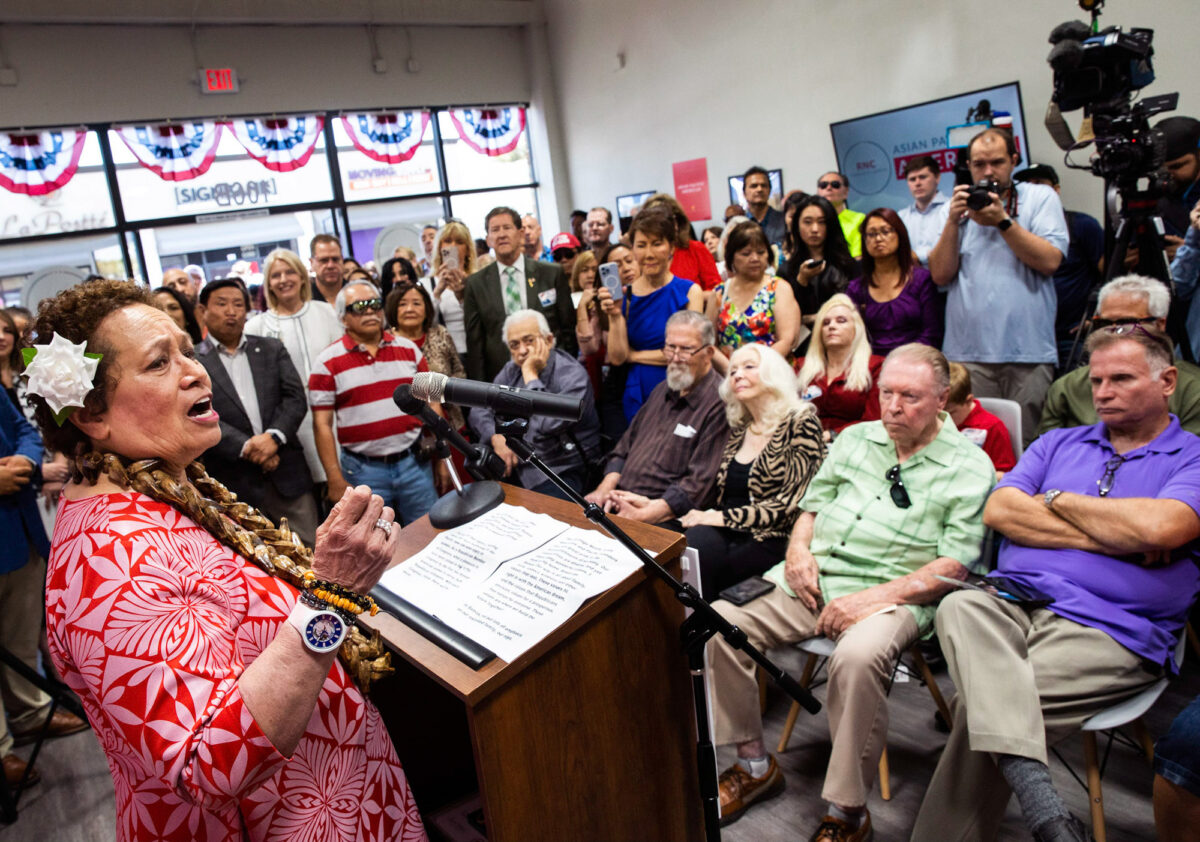
But between concerns about small-business regulation, crime and high prices — in addition to partisan identity being less sticky among AAPI voters, Republicans believe several segments of the bloc are ripe for persuasion.
The Trump campaign in Nevada hosts monthly meetups for “Asian Americans for Trump” and has been tabling at the multitude of festivals, markets and cultural events that take place frequently across the Las Vegas Valley. Candidates such as Brown have made their pitch at the LVACC, and Trump, in polling, is better trusted on the economic issues that community leaders say are AAPI voters’ top concern.
Wood said even if they’re not open about it, AAPI business owners are deeply concerned about prices — and it will likely affect how they vote.
Pauline Lee, the Nevada Republican Club president, believes that younger AAPI voters will vote for Democrats because of their belief in abortion and diversity, equity and inclusion initiatives. But she thinks the economy will drive their parents toward Republicans — not necessarily because of their own economic circumstances, but because of frustration about their college-age or adult children’s struggles.
Such struggles — even among those who went to prestigious universities — undermine the core immigrant belief that moving to America will provide your children with more opportunity — and make middle-aged AAPI voters open to the Republican message, she said.
“The parents that I talk to are like, ‘What do you mean they don't have a job, right?’” she said. “And then they do get a job, and then the kids are saying to them, ‘But I can't afford housing.’”
She added that affirmative action can also be a powerful motivator — Asian American plaintiffs were at the core of the successful court case to end affirmative action in college admissions. (Pew data shows that attitudes toward affirmative action among Asian Americans are mixed.)
Pauline Lee and others have been running a get-out-the-vote operation, particularly hoping to appeal to the large swath of AAPI independents. She said Brown’s candidacy has been helpful in that respect, because he’s going where past Republicans have not.
“What’s really clear is, Republicans have not, in the past, been very responsive to the AAPI community,” she said. “He’s saying look, your values are the Republican values.”
Turnout
AAPI organizers are cautiously optimistic that all of their effort will lead to higher turnout — “God, I sure hope so!” joked Jeng — and build on the gains between 2016 and 2020.
Between the prior two presidential elections, AAPI voters, according to data from progressive firm Catalist, increased their number of votes by 45 percentage points in Nevada, 6 points higher than the national average. About 120,000 AAPI Nevadans voted, making their turnout rate about 57 percent.
Using census tract data, Catalist estimated that Filipino, Vietnamese and Chinese Americans grew their vote share at rates larger than the national average. Given the explosion of registered nonpartisans in every community, modeling can be difficult, but organizers are hoping for higher voter turnout — regardless of who it benefits.
“I would be very surprised if it's not [higher],” Mosca said. “People have been out there. People have been touched. People have been asked. It's on every airwave. It's in every restaurant. Politics in Nevada, it just becomes part of everyday life.”
